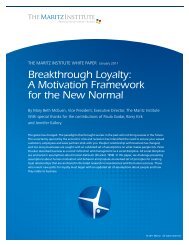The Human Science of Giving Recognition ... - Maritz Institute
The Human Science of Giving Recognition ... - Maritz Institute
The Human Science of Giving Recognition ... - Maritz Institute
You also want an ePaper? Increase the reach of your titles
YUMPU automatically turns print PDFs into web optimized ePapers that Google loves.
THE MARITZ INSTITUTE WHITE PAPER October 2010<br />
<strong>The</strong> <strong>Maritz</strong> <strong>Recognition</strong> Model provides a powerful blueprint for creating high-impact<br />
recognition experiences.<br />
Giver<br />
Behavior<br />
Effect<br />
Thank You<br />
Recipient<br />
Improved<br />
employee<br />
engagement<br />
Improved<br />
alignment<br />
Improved<br />
customer<br />
satisfaction<br />
Greater<br />
performance<br />
B: State the Behavior<br />
<strong>Recognition</strong> too <strong>of</strong>ten stands alone, never connected to specific actions. Explicitly stating<br />
the behavior transforms a general appreciation <strong>of</strong> “who you are and what you do” into a<br />
reinforcement <strong>of</strong> specific behaviors, attitudes or results.<br />
Best Practices<br />
Be specific: Acknowledging the behavior in specific terms is important because it provides the<br />
brain with what it needs to more easily repeat the behavior. A recent study conducted at MIT<br />
provides evidence that when rewarded, the brain remembers what it did right and changes<br />
neural pathways, making brain activity more efficient the next time the activity or decision is<br />
undertaken (Berinato, 2010). In short, recognizing success changes the brain and facilitates the<br />
brain’s ability to repeat the successful activity again.<br />
Be immediate: Because memory distortion and plain old forgetting are unfortunate facts <strong>of</strong><br />
life (Schacter, 2001), recognition should follow the behavior as immediately as possible. Give<br />
praise before you—and the employee forget. Doing so creates a stronger link between the act<br />
<strong>of</strong> recognition and the specific behavior.<br />
Be concise: To maximize the impact <strong>of</strong> recognition, be brief and concise. “Working memory”<br />
is the capacity that enables a person to process the information necessary to complete a given<br />
task (LeDoux, 1996). For example, to understand the meaning <strong>of</strong> this sentence as you read it,<br />
your working memory needs to hold the beginning <strong>of</strong> the sentence as the rest <strong>of</strong> it unfolds.<br />
Although it is one <strong>of</strong> the brain’s most sophisticated capabilities, working memory generally<br />
has very limited capacity (LeDoux, 1996). Working memory can only hold a few isolated items<br />
simultaneously, and it doesn’t hold tightly to anything (Zull, 2002). Furthermore, the more<br />
things that are held in working memory, the harder it is to focus on what is most important<br />
(de Fockert, Rees, Frith & Lavie, 2001). So, when it comes to giving recognition, in any given<br />
setting, less is more. While brevity is especially important when identifying the behavior, it is a<br />
best practice that should be applied through the entire recognition interaction.<br />
E: State the Effect<br />
Behaviors are reinforced positively through recognition, and that positive reinforcement is<br />
further extended by also connecting behaviors to the effect – business or culture-building<br />
results. <strong>The</strong> recognition is the recipient’s connector to these results, with the recognition<br />
having the potential to be more meaningful and longer lasting to the recipient than the<br />
results themselves.<br />
© 2011 <strong>The</strong> <strong>Maritz</strong> <strong>Institute</strong> All rights reserved 5



